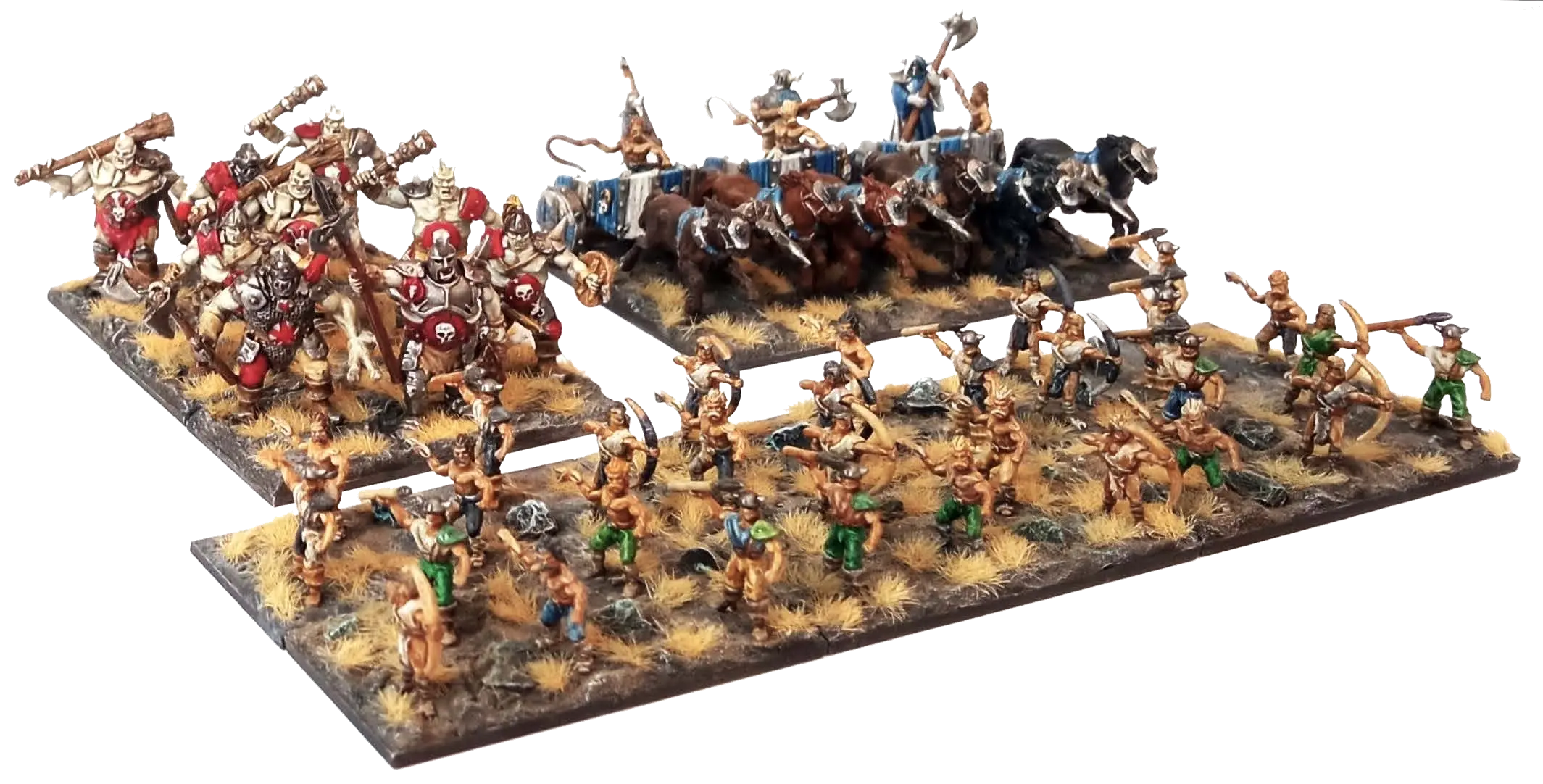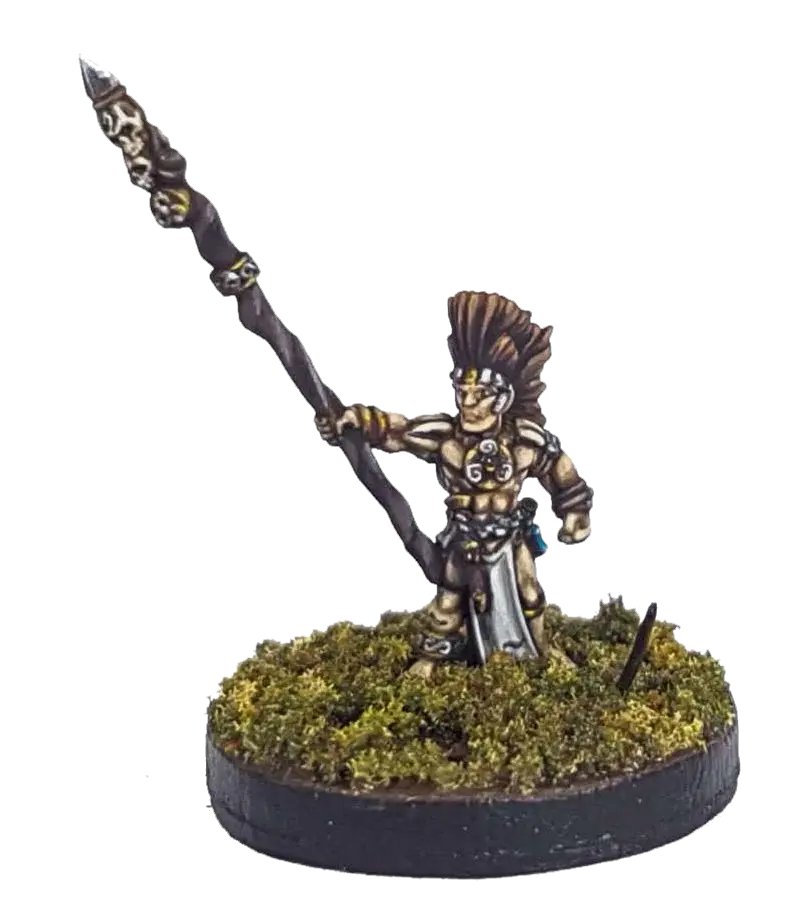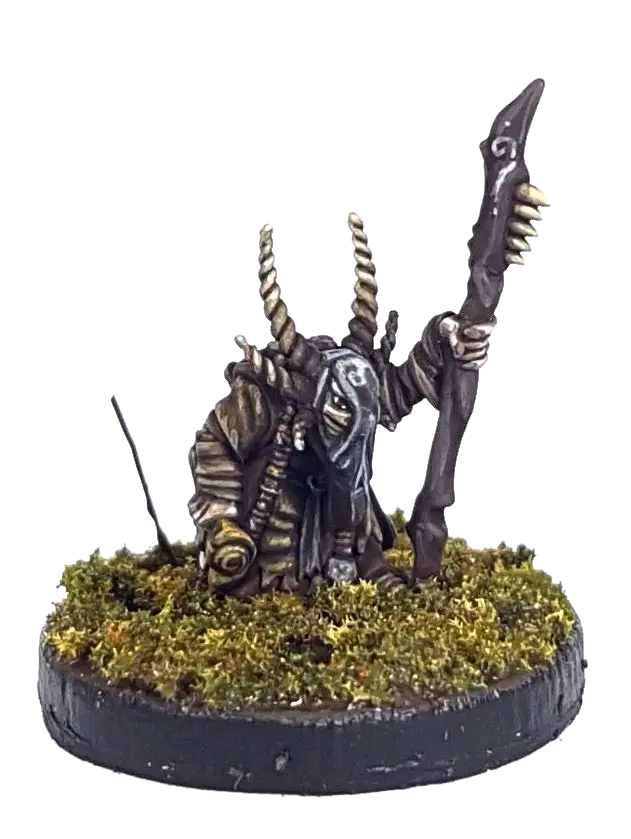Albion
 Il y a très longtemps, l’île d’Albion était le site d’un vaste complexe techno-arcanique créé par une ancienne race capable de naviguer dans l’espace appelée les Slanns. Leurs cercles de pierres soigneusement alignés et les milliers de kilomètres de lignes telluriques précisément disposées leur servaient autrefois à maîtriser le mystérieux pouvoir psychomagique du Warp. Ce pouvoir était utilisé pour contrôler les gigantesques portails par lesquels les vaisseaux Slanns traversaient la galaxie, jusqu’à l’avènement d’un malheureux accident : les portails devinrent instables, ouvrant une faille dans le vide et créant la zone de contamination et d’instabilité temporelle connue aujourd’hui sous le nom de Désolations du Chaos. Afin d’empêcher leurs portails endommagés de devenir incontrôlables et d’engloutir le monde entier, les Slanns détruisirent ou désactivèrent leur complexe de contrôle sur Albion. Une énorme quantité d’énergie psychoactive dangereuse fut alors libérée.
Il y a très longtemps, l’île d’Albion était le site d’un vaste complexe techno-arcanique créé par une ancienne race capable de naviguer dans l’espace appelée les Slanns. Leurs cercles de pierres soigneusement alignés et les milliers de kilomètres de lignes telluriques précisément disposées leur servaient autrefois à maîtriser le mystérieux pouvoir psychomagique du Warp. Ce pouvoir était utilisé pour contrôler les gigantesques portails par lesquels les vaisseaux Slanns traversaient la galaxie, jusqu’à l’avènement d’un malheureux accident : les portails devinrent instables, ouvrant une faille dans le vide et créant la zone de contamination et d’instabilité temporelle connue aujourd’hui sous le nom de Désolations du Chaos. Afin d’empêcher leurs portails endommagés de devenir incontrôlables et d’engloutir le monde entier, les Slanns détruisirent ou désactivèrent leur complexe de contrôle sur Albion. Une énorme quantité d’énergie psychoactive dangereuse fut alors libérée.
Cette catastrophe transforma Albion en une terre distordue, désormais enveloppée de brumes glaciales et d’une pluie incessante. La libération explosive d’énergie warp eut pour effet de tordre le temps et l’espace de manière surprenante. De ce fait, l’île se révéla quasi impossible à atteindre et de nombreux habitants du Vieux Monde en vinrent à douter de son existence même. Isolés du monde et de la réalité, les habitants de l’île dégénérèrent physiquement et culturellement, vivant une existence simiesque aux côtés des autres monstres difformes de leur terre dévastée.
Malgré cela, ils conservent encore quelques vestiges de souvenirs d’une époque de grandeur où leurs ancêtres aidèrent à construire les cercles de pierres et autres merveilles qui formaient autrefois le centre névralgique de la machine techno-arcanique du warp des Slanns.
L’île enveloppée de brume a connue autant de carnages et de guerres que le reste du monde connu. Albion est perçue comme un endroit reculé, humide et marécageux, et les rapports d’incursions récentes se sont concentrés sur les affrontements entre des envahisseurs supposément plus avancés. Cependant, un examen plus approfondi des campagnes menées en Albion révèle que ses armées indigènes sont tout aussi meurtrières que celles de n’importe quelle nation dite « civilisée ».
Le cœur de toute armée d’Albion est composé de nobles sur des chars et de bandes de guerriers à pied, entourées de jeunes hommes armés de frondes et de javelots, menés par le chef local. Les nobles les plus pauvres et les guerriers les plus riches sont montés sur de robustes poneys indigènes et forment la cavalerie utilisée à la fois pour partir en reconnaissance ainsi que soutenir les nobles sur char.
Albion est célèbre pour ses grands chiens de chasse élevés par les autochtones. Ils sont largement exportés, notamment en Bretonnie et dans l’Empire, où leur taille, leur force et leur férocité sont très prisées des chasseurs nobles. En temps de guerre, ces chiens de chasse sont rassemblés en d’immenses meutes baveuses et servent à épauler la cavalerie, la protégeant des attaques et harcelant les flancs ennemis vulnérables.
En temps de guerre, certains chefs peuvent également faire appel aux aigles géants dont les aires parsèment les plus hauts sommets du pays. Rares sont les chefs d’Albion qui laisseront passer l’occasion de recruter certains des plus grands habitants de leur île : les célèbres géants d’Albion. À l’instar des géants qui accompagnent les armées orques, ces guerriers massifs compensent leur manque d’intelligence par leur force physique !
Moins puissantes, mais aussi moins stupides, les bandes d’ogres affluent pour rejoindre les armées d’Albion – pour une part du butin et la possibilité de transformer un ancien ennemi en un casse-croûte rapide ! Outre les chefs guerriers qui dirigent les armées, des guerriers héroïques aident à les organiser, aux côtés des énigmatiques druides, qui sont non seulement les sorciers de l’armée, mais aussi ses législateurs, juges et devins.

Sélecteur d’armée d’Albion
| Troupe | Type | Attaques | Points de Vie (PV) | Armure | Commandement (Cdt) | Taille d’unité | Points par unités | Min/max | Spécial |
|---|---|---|---|---|---|---|---|---|---|
Guerriers |
Infanterie |
3 |
3 |
5+ |
– |
3 |
60 |
2/– |
– |
Frondeurs |
Infanterie |
2/1 |
3 |
– |
– |
3 |
40 |
1/6 |
– |
Ogres |
Infanterie |
4 |
4 |
5+ |
– |
3 |
105 |
–/2 |
|
Chiens de Chasse |
Cavalerie |
3 |
3 |
– |
– |
3 |
40 |
–/6 |
– |
Cavalerie |
Cavalerie |
3 |
3 |
5+ |
– |
3 |
90 |
–/4 |
– |
Chars |
Char |
3 |
3 |
5+ |
– |
3 |
95 |
1/4 |
– |
Géants |
Monstre |
8 |
8 |
5+ |
– |
1 |
135 |
–/1 |
|
Aigles Géants |
Monstre |
2 |
3 |
6+ |
– |
3 |
70 |
–/1 |
|
Bêtes des marais |
Monstre |
6 |
4 |
5+ |
– |
1 |
0 |
–/1 |
|
|
|||||||||
Général |
Général |
+2 |
– |
– |
9 |
1 |
125 |
1 |
– |
Héros |
Héros |
+1 |
– |
– |
8 |
1 |
80 |
–/2 |
– |
Druide |
Sorcier |
+0 |
– |
– |
7 |
1 |
45 |
–/1 |
– |
Aigles Géants |
Monstre monté |
+2 |
– |
– |
– |
– |
+20 |
–/1 |
|
Char |
Char monté |
+1 |
– |
– |
– |
– |
+10 |
–/1 |
Règles Spéciales
- 1. Ogres
-
Si une unité d’ogres peut utiliser son initiative pour charger une unité d’humains (littéralement humains… ce qui inclut les Guerriers et Maraudeurs du Chaos, mais pas les Nains, les Elfes et autres humanoïdes) au début de la phase d’Ordres, elle doit le faire, quels que soient les désirs de leur commandant.
- 2. Géant
-
Les Géants doivent toujours recevoir des ordres séparés. Ils ne peuvent pas rejoindre des brigades d’autres troupes mais peuvent constituer des brigades de Géants. Si vous tentez de donner un ordre à un Géant et que vous échouez, vous devez effectuer un test pour voir ce qui se passe. Ne vous inquiétez pas des éventuelles gaffes, elles sont prises en compte dans le tableau ci-dessous. Lancez un dé et consultez le Tableau de Démence du Géant. Lorsque les Géants sont regroupés en brigades, faites un jet par Géant.
Un Géant possède beaucoup de Points de Vie (8). Il serait donc très difficile d’en venir à bout même lors d’un même combat. À cause de cela, nous devons considérer la possibilité que les blessures subies réduisent son efficacité au combat. De ce fait, si un géant a accumulé entre 5 et 7 touches à la fin d’une phase de Tir ou de Combat, et qu’il n’est plus engagé, il est grièvement blessé. Une fois qu’un Géant est grièvement blessé, toutes les touches accumulées jusque-là sont annulées mais ses Attaques et ses Points de Vie sont réduits de moitié pour le reste de la partie (4 Attaques et 4 Points de Vie).
Un Géant provoque la terreur.
- 3. Aigles géants
-
Les Aigles Géants peuvent voler.
- 4. Monture Aigle Géant
-
Seuls les Druides peuvent voler sur des Aigles Géants.
Un Aigle Géant peut voler, il augmente donc le mouvement de son cavalier de 60 à 100 cm.
Il ajoute également +2 Attaques au profil de son cavalier.
- 5. Char Monté
-
Les Généraux, les Druides et les Héros peuvent monter sur un Char.
Ce qui ajoute +1 Attaque à leur profil.
- 6. Bêtes des marais
-
Les Bêtes des marais forment une unité à part entière, mais ne sont pas alignées sur le champ de bataille de la manière habituelle. Elles sont invoquées par un Druide en lançant le sort d’Invocation de Bêtes des marais.
Une Bête des marais ne peut former une brigade avec d’autres unités, même d’autres Bêtes des marais. Les Bêtes des marais n’utilisent jamais l’initiative pour bouger lors de la Phase d’Ordre. Les Druides ont une valeur de Commandement augmentée de +1 quand ils donnent des ordres aux Bêtes des marais, c’est-à-dire 8 au lieu de 7, car elles sont entièrement dominées par la volonté de ceux qui les ont invoquées.
Les Bêtes des marais peuvent traverser les marais comme si c’était du terrain dégagé, et peuvent laisser passer les unités alliées de la manière habituelle.
Les Bêtes des marais provoquent la terreur.

Sorts d’Albion
Averse
4+ pour lancer Portée 30cm
Le Druide fait tomber une pluie fine et glacée sur ses ennemis.
Jusqu’au début du prochain tour du joueur Druide, toutes les unités ennemies à 30 cm ou moins du Druide qui lance le sort subissent un malus de -1 à leur commandement.
Tempête de Grêle
5+ pour lancer Portée 30cm
Le Druide exploite la puissance météorologique pour attaquer ses ennemis avec d’énormes grêlons.
Le Druide cible une unité ennemie à portée qu’il peut voir. Le sort est traité comme 3 attaques de tir ordinaires, si ce n’est que l’armure de la cible est ignorée (elle compte comme n’ayant pas d’Armure). Une unité peut être repoussée par la Tempête de Grêle comme par une attaque de tir normale.
Brumes d’Albion
5+ pour lancer Portée 30cm
Le Druide exhale la même brume mystique qui entoure les terres d’Albion et enveloppe ses compatriotes, les rendant difficiles à cibler par les troupes ennemies.
Ce sort peut être lancé sur une seule unité d’infanterie amie non engagée au corps à corps et à portée, que le lanceur puisse la voir ou non. Le sort dure jusqu’au début du prochain tour du lanceur, ou jusqu’à ce que l’unité ciblée se déplace de quelque façon que ce soit. L’unité d’infanterie ciblée est considérée comme étant Défendue, même en terrain découvert.
Invocation de Bêtes des marais
6+ pour lancer Portée 30cm
Le Druide exécute l’un des rituels les plus mystérieux de son ordre, utilisant son pouvoir sur les éléments pour se lier à la créature terrifiante connue sous le nom de Bête des marais.
Le Druide invoque une Bête des marais. Une fois invoquée, elle est sous le contrôle du joueur qui l’invoque.
Puisqu’elle est invoquée lors de la phase de Tir, elle ne peut recevoir d’ordres qu’au tour suivant. Elle ne peut être invoquée au contact d’une unité ennemie que si celle-ci est déjà en combat. Elle est retirée du jeu si elle est détruite (comme toute autre unité) ou si la perte d’un personnage Druide réduit le nombre de Druides à un niveau inférieur à celui des Bêtes des Marais ; le joueur qui la possède choisit une Bête des marais et la retire du jeu.
Les unités de Bêtes des marais invoquées ne comptent pas dans le calcul du seuil de déroute de l’armée et n’ont pas de valeur en points.
Seuls les Druides peuvent donner des ordres aux Bêtes des marais. Elles ne peuvent pas être mises en brigade avec d’autres troupes, même avec d’autres Bêtes des marais. Une armée ne peut pas avoir plus de Bêtes des marais invoquées en jeu que de Druides.
